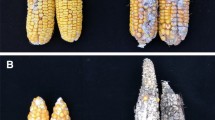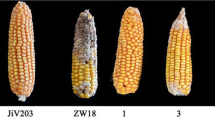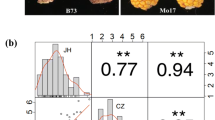Abstract
Fusarium ear rot is a prevalent disease in maize, reducing grain yields and quality. Resistance breeding is an efficient way to minimize losses caused by the disease. In this study, 187 lines from a RIL population along with the resistant (87-1) and susceptible (Zong 3) parents were planted in Zhengzhou and Beijing with three replications in years 2004 and 2006. Each line was artificially inoculated using the nail-punch method. Significant genotypic variation in response to Fusarium ear rot was detected in both years. Based on a genetic map containing 246 polymorphic SSR markers with average genetic distances of 9.1 cM, the ear-rot resistance QTL were firstly analyzed by composite interval mapping (CIM). Three QTL were detected in both Zhengzhou and Beijing in 2004; and three and four QTL, respectively, were identified in 2006. The resistant parent contributed all resistance QTL. By using composite interval mapping and a mixed model (MCIM), significant epistatic effects on Fusarium ear rot as well as interactions between mapped loci and environments were observed across environments. Two QTL on chromosome 3 (3.04 bin) were consistently identified across all environments by the two methods. The major resistant QTL with the largest effect was flanked by markers umc1025 and umc1742 on chromosome 3 (3.04 bin), explaining 13–22% of the phenotypic variation. The SSR markers closely flanking the major resistance QTL will facilitate marker-assisted selection (MAS) of resistance to Fusarium ear rot in maize breeding programs.

Similar content being viewed by others
References
Boling MB, Grogan CO (1965) Gene action affecting host resistance to Fusarium ear rot of maize. Crop Sci 5:305–307
Churchill GA, Doerge RW (1994) Empirical threshold values for quantitative trait mapping. Genetics 138:963–971
Clements MJ, White DG (2004) Identifying sources of resistance to Aflatoxin and Fumonisin contamination in corn grain. J Tox Tox R 23:381–396
Davis RM, Kegel FR, Sills WM, Farrar JJ (1989) Fusarium ear rot of corn. Calif Agric 43:4–5
Drepper WJ, Renfro BL (1990) Comparision of methods for inoculatation of ears and stalks of maize with Fusarium moniliforme. Plant Dis 74:952–956
Dutton MF (1996) Fumonisins, mycotoxins of increased importance: their nature and their effects. Pharmacol Ther 70:137–161
Gelderblom WCA, Jaskiewicz K, Marasas WFO, Thiel PG, Horak RM, Vleggaar R, Kriek NP (1988) Fumonisins: novel mycotoxins with cancer-promoting acitivity producted by Fusarium moniliforme. Appl Environ Microbiol 54:1806–1811
Hua JP, Xing YZ, Xu CG, Sun XL, Yu SB, Zhang QF (2002) Genetic dissection of an elite rice hybrid revealed that heterozygotes are not always advantageous for performance. Genetics 162:1885–1895
Hua JP, Xing YZ, Wei WR, Xu CG, Sun XL, Yu SB, Zhang QF (2003) Single-locus heterotic effects and dominance by dominance interactions can adequately explain the genetic basis of heterosis in an elite rice hybrid. Proc Natl Acad Sci USA 100:2574–2579
Knapp SJ, Stroup WW, Ross WM (1985) Exact confidence intervals for heritability on a progeny mean basis. Crop Sci 25:192–194
Koehler B (1942) Natural mode of entrance of fungi into corn ears and some symptoms that indicate infection. J Agric Res 64:421–442
Kosambi DD (1944) The estimation of map distances from recombination values. Ann Eugen 12:172–175
Lander ES, Green P, Abrahanson J (1987) MAPMAKER: an interactive computer package maps of experimental and natural populations. Genomics 1:174–181
Li ZK, Pinson SRM, Park WD, Paterson AH, Stansel JW (1997) Epistasis for three grain yield components in rice (Oryza sativa L.). Genetics 145:453–465
Li ZK, Luo LJ, Mei HW, Wang DL, Shu YQ, Tabien R, Zhong DB, Ying CS, Stansel JW, Khush GS, Paterson AH (2001) Overdominance epistatic loci are the primary genetic basis of inbreeding depression and heterosis in rice. I. Biomass and grain yield. Genetics 158:1737–1753
Liu XH (2004) The study on heterotic grouping of several maize inbred lines. Dissertation, China Agricultural University. Beijing, China
Lukens LN, Doebley J (1999) Epistatic and environmental interactions for quantitative trait loci involved in maize evolution. Genet Res 74:291–302
Luo LJ, Li ZK, Mei HW, Shu QY, Tabien R, Zhong DB, Ying CS, Stansel JW, Khush GS, Paterson AH (2001) Overdominant epistatic loci are the primary genetic basis of bnbreeding bepression and heterosis in rice. II. Grain yield components. Genetics 158:1755–1771
Ma XQ, Tang JH, Teng WT, Yan JB, Meng YJ, Li JS (2007) Epistatic interaction is an important genetic basis of grain yield and its components in maize. Mol Breeding 20:41–51
McMullen MD, Simcox KD (1995) Genomic organization of disease and insect resistance genes in maize. Mol Plant Microbe Interact 8:811–815
Mei HW, Luo LJ, Ying CS, Wang YP, Yu XQ, Guo LB, Paterson AH, Li ZK (2003) Gene actions of QTLs affecting several agronomic traits resolved in a recombinant inbred rice population and two testcross populations. Theor Appl Genet 107:89–101
Mei HW, Li ZK, Shu QY, Guo LB, Wang YP, Yu XQ, Ying CS, Luo LJ (2005) Gene actions of QTL affecting several agronomic traits resolved in a recombinant inbred rice population and two backcross population. Theor Appl Genet 110:649–659
Melchinger AE, Kuntze L, Gumber PK, Lubberstedt T, Fuchs E (1998) Genetic basis of resistance to sugarcane mosaic virus in European maize germplasm. Theor Appl Genet 96:1151–1161
Nankam C, Pataky JK (1996) Resistance to kernel infection by Fusarium moniliforme in the sweet corn inbred IL125b. Plant Dis 80:593–598
Pé ME, Gianfranceschi L, Taramino G, Tarchini R, Angelini P, Dani M, Binelli G (1993) Mapping quantitative trait loci (QTLs) for resistance to Gibberella zeae infection in maize. Mol Gen Genet 241:11–16
Pérez-Brito S, Jeffers D, Gonzàlez-de-León D, Khairallah M, Cortés-Cruz M, Velàzquez-Cardelas G, Azpiroz-Rivero S, Srinivasan G (2001) QTL mapping of Fusarium moniliforme ear rot resistance in highland maize, México. Agrociencia 35:181–196
Reid LM, Mather DE, Bolton AT, Hamilton RI (1994) Evidence for a gene for silk resistance to Fusarium graminearum Schw. ear rot of maize. J Heredity 85:118–121
Ren JP (1993) Preliminary study in maize ear rot. Maize Sci 1:75–79
Robertson-Hoyt LA, Jines MP, Balint-Kurti PJ, Kleinschmidt CE, White DG, Payne GA, Maragos CM, Molnar TL, Holland JB (2006) QTL mapping for Fusarium ear rot and Fumonisin contamination resistance in two maize populations. Crop Sci 46:1734–1743
SAS Institute (1999) SAS users guide: statistic. SAS Institute, Cary, NC
Teng WT, Cao QS, Chen YH, Liu XH, Jing XQ, Zhang FJ, Li JS (2004) Analysis of maize heterotic groups and patterns during past decade in China. Agric Sci China 3:481–489
Wang DL, Zhu J, Li ZK, Paterson AH (1999) Mapping QTLs with epistatic effects and QTL × environment interactions by mixed linear model approaches. Theor Appl Genet 99:1255–1264
Weidenborner M (2001) Foods and fumonisins. Eur Food Res Technol 212:262–273
Xing YZ, Tan YF, Hua JP, Sun XL, Xu CG, Zhang QF (2002) Characterization of the main effects, epistatic effects and their environmental interactions of QTLs on the genetic basis of yield traits in rice. Theor Appl Genet 105:248–257
Xu SB, Tao YF, Yang ZQ, Zhu JY (2002) A simple and rapid method used for silver staining and gel preservation. Heredity 24:335–336
Yan JB, Tang H, Huang YQ, Zheng YL, Li JS (2006) Quantitative trait loci mapping and epistatic analysis for grain yield and yield components using molecular markers with an elite maize hybrid. Euphytica 149:121–131
Yu SB, Li JX, Xu CG, Tan YF, Gao YJ, Li XH, Zhang QF, Saghai Maroof MA (1997) Importance of epistasis as the genetic basis of the heterosis in an elite rice hybrid. Proc Natl Acad Sci USA 94:9226–9231
Zeng ZB (1994) Precision mapping of quantitative trait loci. Genetics 136:1457–1468
Acknowledgements
This work was supported by the Chinese High Technology Project. The authors acknowledge the help of Professor R. A. McIntosh for language editing.
Author information
Authors and Affiliations
Corresponding author
Rights and permissions
About this article
Cite this article
Ding, JQ., Wang, XM., Chander, S. et al. QTL mapping of resistance to Fusarium ear rot using a RIL population in maize. Mol Breeding 22, 395–403 (2008). https://doi.org/10.1007/s11032-008-9184-4
Received:
Accepted:
Published:
Issue Date:
DOI: https://doi.org/10.1007/s11032-008-9184-4




